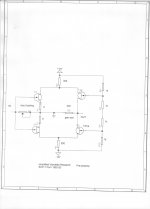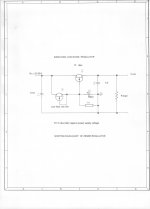I gave up at "Jitter is a major cause of distortion in digital systems,".
Their picture of jitter's effects was certainly a distortion of reality.
Obviously an attempt to explain it more clearly to unwashed people.Their picture of jitter's effects was certainly a distortion of reality.
May-be a good occasion to ask people here, really experienced in digital, their opinion on this subject ? Both in measurements results and listening impressions ?
I found noticeable differences in listening (sighted and flawed as usual ;-), between average and good clocks (including low noise power supplies for them) while I was modifying my DCX2496. But not such obvious than the analog side.
As I made several modifications at the same time, and my impressions were based on memory, hard to make myself a definitive opinion. Correlating with other trusted ones can help.
Last edited:
Tournesol,
Something I wrote in another thread, but more or less sums up my views on modding most dacs (although I am willing to be convinced otherwise): Starting with a cheap dac and swapping in some easy to change parts is not likely to get one very far in most cases, whether or not particular changes hurt or help accuracy of reproduction (perhaps some of both is common). One big problem with trying to do it is because many low cost dacs are not mod-able enough so as to make it possible to fix all the things that are wrong, which is usually almost everything. Why everything? Because low cost dacs or other audio components are built to a price point and if well designed they should be pretty well optimized for their market sector by the designer(s) to be close to equally compromised everywhere, in a balanced and carefully considered way. Chances of a really good designer making stupid mistakes and building a great dac, but with only a few easily changed bad parts should be very low. Wouldn't be a very good designer in that case.
Something I wrote in another thread, but more or less sums up my views on modding most dacs (although I am willing to be convinced otherwise): Starting with a cheap dac and swapping in some easy to change parts is not likely to get one very far in most cases, whether or not particular changes hurt or help accuracy of reproduction (perhaps some of both is common). One big problem with trying to do it is because many low cost dacs are not mod-able enough so as to make it possible to fix all the things that are wrong, which is usually almost everything. Why everything? Because low cost dacs or other audio components are built to a price point and if well designed they should be pretty well optimized for their market sector by the designer(s) to be close to equally compromised everywhere, in a balanced and carefully considered way. Chances of a really good designer making stupid mistakes and building a great dac, but with only a few easily changed bad parts should be very low. Wouldn't be a very good designer in that case.
Just to make my statement clear: Of course there is a 3dB penalty for using differential. This is taught in university classrooms, etc and in many textbooks. This is obviously because you have to put 2 active devices in SERIES and their noise adds in the usual way.
So if you remain single ended, you gain that 3dB, but there is more with the Vendetta!
By putting a COMPLEMENTARY jfet also on the input, you have effectively put an active device in PARALLEL, which reduces the noise by 3dB. The Vendetta then DOUBLES the number of both types of input device to get another 3dB. So the total improvement is 9dB over a single differential pair.
So if you remain single ended, you gain that 3dB, but there is more with the Vendetta!
By putting a COMPLEMENTARY jfet also on the input, you have effectively put an active device in PARALLEL, which reduces the noise by 3dB. The Vendetta then DOUBLES the number of both types of input device to get another 3dB. So the total improvement is 9dB over a single differential pair.
By putting a COMPLEMENTARY jfet also on the input, you have effectively put an active device in PARALLEL, which reduces the noise by 3dB. The Vendetta then DOUBLES the number of both types of input device to get another 3dB. So the total improvement is 9dB over a single differential pair.
6dB over a single differential pair. With 4x more unobtanium. Great deal!
I and many others have noticed differences too in sighted and flawed listening comparisons of DACs.I found noticeable differences in listening (sighted and flawed as usual ;-), between average and good clocks (including low noise power supplies for them)
What's wrong with the sound of those so called wrongly made DACs? Can you hear a difference between those and DACs that are made rightly? If you can, how did you discover it?One big problem with trying to do it is because many low cost dacs are not mod-able enough so as to make it possible to fix all the things that are wrong, which is usually almost everything. Why everything? Because low cost dacs or other audio components are built to a price point and if well designed they should be pretty well optimized for their market sector by the designer(s) to be close to equally compromised everywhere, in a balanced and carefully considered way.
I don't know the schematic but -3(dif)+3(compl)+3(parallel)=+3db...Would you , please indicate a link with the schematic?Sorry if i got it completely wrong!Just to make my statement clear: Of course there is a 3dB penalty for using differential. This is taught in university classrooms, etc and in many textbooks. This is obviously because you have to put 2 active devices in SERIES and their noise adds in the usual way.
So if you remain single ended, you gain that 3dB, but there is more with the Vendetta!
By putting a COMPLEMENTARY jfet also on the input, you have effectively put an active device in PARALLEL, which reduces the noise by 3dB. The Vendetta then DOUBLES the number of both types of input device to get another 3dB. So the total improvement is 9dB over a single differential pair.
The Vendetta then DOUBLES the number of both types of input device to get another 3dB. So the total improvement is 9dB over a single differential pair.
Sorry John, we get to double up the diff pair too so 6dB for the same $$. This is all beside the point several designs have been presented over the last few years with ordinary parts that are between 0.28 and 0.4nV. In fact there are several 0.9nV op-amps out there and paralleling 5 yields 0.4nV and I'm not sure adding $10 or so to the BOM on these absurd $30,000 + pre-amps would make any difference.
Whoa, that was completely inaccurate. I shouldn't rely on fading memory, sorry for the error.
It was the LM381 (ends in 1) which offered the half-LTP option for superior noise. You get that by shorting pin 2 to pin 3. Correct datasheet attached below.
_
I built an RIAA preamp with one of that nat semi devices in about 78 or possibly 79 but it oscillated and I was never able to find the problem given my level of knowledge at the time. I see these data sheets are marked c. 1987, but I think they predate that by many years, unless it was another part that I used.
Anyway, good info - thanks for posting.
My impression is that the LSK/LSJ supply is kept to a minimum, to drive/keep the prices up.
Most of the devices go to the military by a very wide margin, audiophiles come lower down but they still support us.
Actually the real problem with supply of the LS device is YIELD. They just have had poor yields of the LSJ74 for years, apparently until recently. They called me last week and have assured me that amateurs will have a better chance with getting true complements of low noise jfets.
I am going to put up a few simplified schematics that show why the Vendetta is so quiet. Remember, this was 35+ years ago when it was designed. Any improvements since then?
Attachments
Improvements? Certainly. Digital audio - vastly better than vinyl and the kludges needed to make it vaguely acceptable....
pos: LT3042, LT3045
neg: LT3094
TPS7A47xx positive
TPS7A33 negative
Thank you. If you need fixed 5V there is cheap AKM AK1110 (dual LDO, one is 6nV/sqrtHz, second is 3nV/sqrtHz)
Actually the real problem with supply of the LS device is YIELD. They just have had poor yields of the LSJ74 for years, apparently until recently. They called me last week and have assured me that amateurs will have a better chance with getting true complements of low noise jfets.
They have fixed the P yield and the devices are pretty nice. Still less then a vacuum tube and you don't have to worry if they are breaking in or burning out like tubes.
I dont see any significant difference between bipolar and fet for audio. Neither for Noise nor harmonic-wise.
Both can give ultra low noise and both can have only 2H and 3H dominant in any modern topology. Maybe for phono cart and direct coupled there is some advantage to use fets. Like high Zin and low current thru cart. But thats all I can think of.
What else?
THx-RNMarsh
Both can give ultra low noise and both can have only 2H and 3H dominant in any modern topology. Maybe for phono cart and direct coupled there is some advantage to use fets. Like high Zin and low current thru cart. But thats all I can think of.
What else?
THx-RNMarsh
Last edited:
The transfer function (exponential) of the bipolar is worse than the fet which is (square law).
Last edited:
The transfer function (exponential) of the bipolar is worse than the fet with is (square law).
yes, just as.. per text books. But in practice, i dont see it show up in the output.... only 2H and 3H at the output with good topologies.
THx-RNMarsh
Last edited:
- Status
- Not open for further replies.
- Home
- Member Areas
- The Lounge
- John Curl's Blowtorch preamplifier part III

